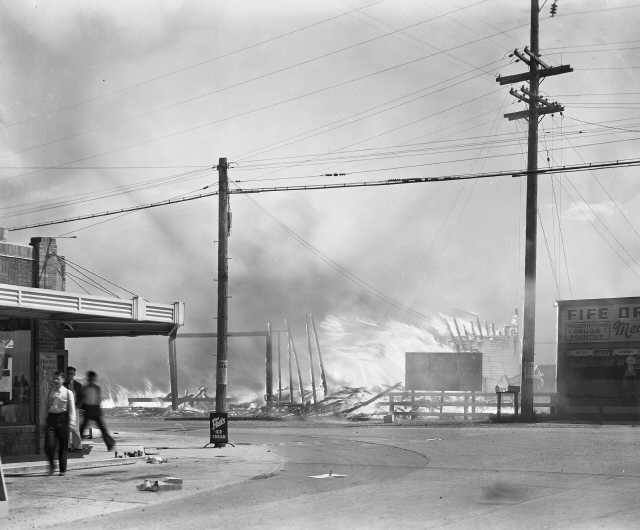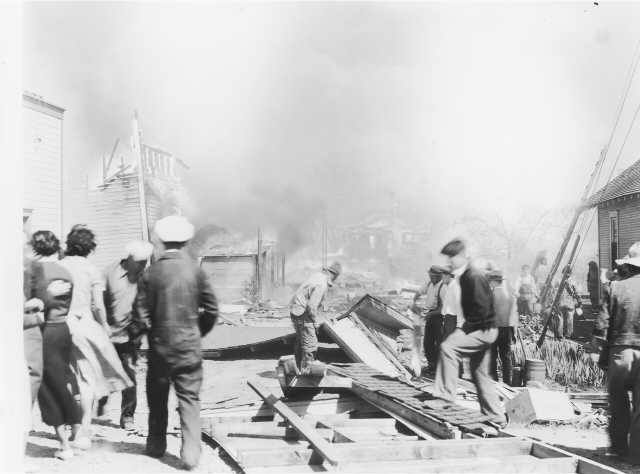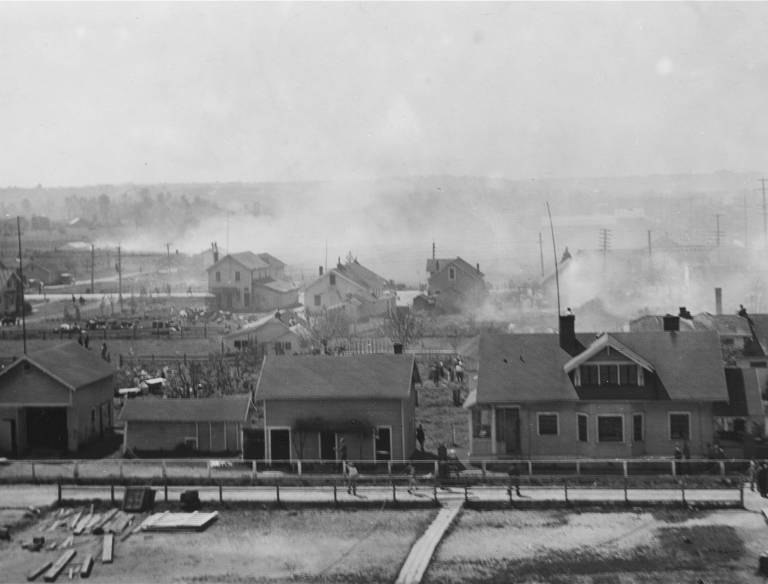On the tinder dry Thursday morning of May 9, 1935 a small fire began in a flower shed at McAleer Gardens a quarter mile south of the agricultural village that clustered around the rural intersection of 20th Street East and 54th Avenue. In those days it was called Fife Corners on the old Valley Road from Fife to Puyallup and it was known by a landmark stone fountain that was still used to water horses and animals. The accidental spark of a fire happened to coincide with a freakish 30 mile an hour wind that rose quickly out of the southwest. In just minutes 11 small worker residences and a boarding house operated by Kay Yamamoto were completely consumed and the whipping fire then leaped 300 yards to the larger homes of the Murray and Hayashi families. During the Depression, Fife Corners was a center for flower and vegetable growers. Everyone literally knew everyone else’s business. The next door neighbors that were among the first to lose their homes that day were typical of the community, one family Nisei Japanese and the other traced back to European settlers.
Beyond Mrs. Hayashi’s house was her father’s building just up wind from the Corners, the massive Kibe Produce Company warehouse stacked full that Spring with the creates and boxes to be used later at harvest time. The first embers reached the building about the time the first people got there with barrels, buckets, and water soaked burlap bags. No fire trucks or pump engines. The fire fight was going to be by hand.


There never was any chance that the community could save the Kibe Company warehouse. It was lost in the first brittle sounding explosion of wind and fire, belching burning embers in every direction. A bucket line had formed between the fountain and the blaze but they fell back when it suddenly became obvious that the very center of Fife Corners was directly in the path of disaster. Just after noon the big bungalow style Burnett house burned with all its contents. Someone frantically drove a truck into the supports of a garage next to the burning warehouse and a crew of volunteers tore it apart trying to starve the fire of fuel and save Mr. Kibe’s home and the corner Fife Drug Store. At the same time, neighbors began rushing into houses spilling furniture and possessions into the street to save them from the multiple house fires. Model A pickup trucks and wagons carried water to the fire in milk cans and feed troughs. Families defended their houses with garden hoses. The fountain went nearly dry so its water was reserved for soaking burlap bags, feed sacks and even leather gloves to be used in slapping at the flames. By early afternoon, the streets were full of spectators and volunteers looking for some way to help but with no water there was very little to be done. The Drug store was consumed along with several more houses. In the Fife Corner Grocery Store across the street, bananas hanging in the window were blackened before the plate glass shattered in the brick building. A reporter found Makoto Kibe standing near the ruins of his home and business unable to answer the question of whether he would rebuild or not. A news photographer began taking pictures while the fires literally surrounded the Corners.



By mid-afternoon there were still no fire trucks but the wicked wind had died down. Fife High School nearby cancelled classes and sent the students home. Many of them walked over to help with the fire or just join the onlookers. It was a strange view with a crowd of people standing or milling round in the middle of the Corners intersection, curious and bewildered. The buildings on three of the corners were burned to the ground. In every direction there were piles of furniture and belongings heaped in yards and on the street around the ashes of missing houses. On most of the surviving houses people were standing on the roof soaking down shingles or on ladders passing up water buckets. A reporter wrote that the landscape “took on the appearance of a war-stricken village hastily evacuated”. More than 20 commercial buildings and homes were lost before the fires were extinguished. With the fire fight over a stream of water began to refill the landmark fountain at the center of the destruction.
In the weeks and months that followed Makoto Kibe rebuilt his warehouse and family homes. The Burnetts and Murrays also rebuilt as did the commercial building owners. McAleer Gardens did not reopen under that name after the fire but Fife Corners did recover resolutely and 1936 was a good year for produce and flowers. In May 1942 more than 1000 Japanese farmers and their families were relocated from the Fife Valley to barracks constructed at the Puyallup fairgrounds. Most of them spent the Second World War at the Minidoka Camp in Idaho. After the war, Interstate 5 was built between Fife Corners and the downtown. Today the intersection is almost unrecognizable with freeway ramps and signage, gas stations and the edge of the government center for the City of Fife.. The days of Fife Corners and the fight of its life seem almost forgotten, like smoke carried away by the wind, except for a striking stone landmark. The fountain, hardened veteran of the Fife Corner fire, now marks the center of the city.







GOOD FIFE HISTORY LESSON
LikeLike
Michael, just to let you know, “Murray” should be “Murrey.”
LikeLiked by 1 person
Fascinating! I grew up very near there and I have never heard about this. Thank you for sharing.
LikeLike
I am the daughter of George Katsumi Yamamoto, who was the son of Kichigoro Kay John Yamamoto, the man who inherited the McAleer Gardens (as it is referred to in your article.) My grandfather, Kay John was dedicated to John McAleer and when he died, he left his land to my grandfather and not to his own children. McAleer’s children contested the will, but the will stood up in court. Apparently, my uncle’s name was on the will, Ray Yamamoto, since he was the eldest child and land could not be inherited by someone who was not a naturalized citizen. The McAleer property taken from our hands during the war, but it was my father, George K. Yamamoto who was determined to earn the property back (which he did) and more. During the war, Kichigoro was taken from his wife, Masae in the night and sent to Manzanar. My father and his family were to report to the Puyallup fairgrounds which they did, but he told the officials there that he had left something back at the house. Previously, he had been contacted by a group of people who were trying to aid Japanese Americans. They contacted resilient able-bodied young Japanese men to smuggle back east so their families would not face poverty when the war ended. My father told me he had to trust his instinct and that this was hope for his family. As promised, he met a man back at their home and my father crouched down beneath a blanket on the floor of a pickup truck with a huge drum of gasoline in the back so they wouldn’t have to stop at gas stations along the way to refill. Late at night, as they approached the border of eastern Washington where policeman were checking vehicles they hit a rut in the road and the gasoline drum bounced out of the truck and onto the road. My dad said that was when he believed in the power of super human strength in times of necessity because the man got out and lifted the full drum of gasoline by himself back onto the truck bed. Eventually my dad made it to Chicago where he was helped by Jewish families. This story was told to me by my father and I think of it as an Underground Railroad system that existed because I believe my father was not the only one who was assisted. My father passed away many years ago when he was 62 and he knew the name of the Jewish family that helped him, but I never wrote it down. I hope to find their name someday to thank them for giving my family hope in a challenging time in their family history.
LikeLike
Hi Mary Jane
I have been working on the story of Kay and Ray and would love to talk with you. Can you email me at
Michael@artifacts-inc.com
LikeLike
Mary Jane
I’m the editor of this blog and have a letter and papers from your family I’d love to share with you. Is there a way I can contact you?
LikeLike